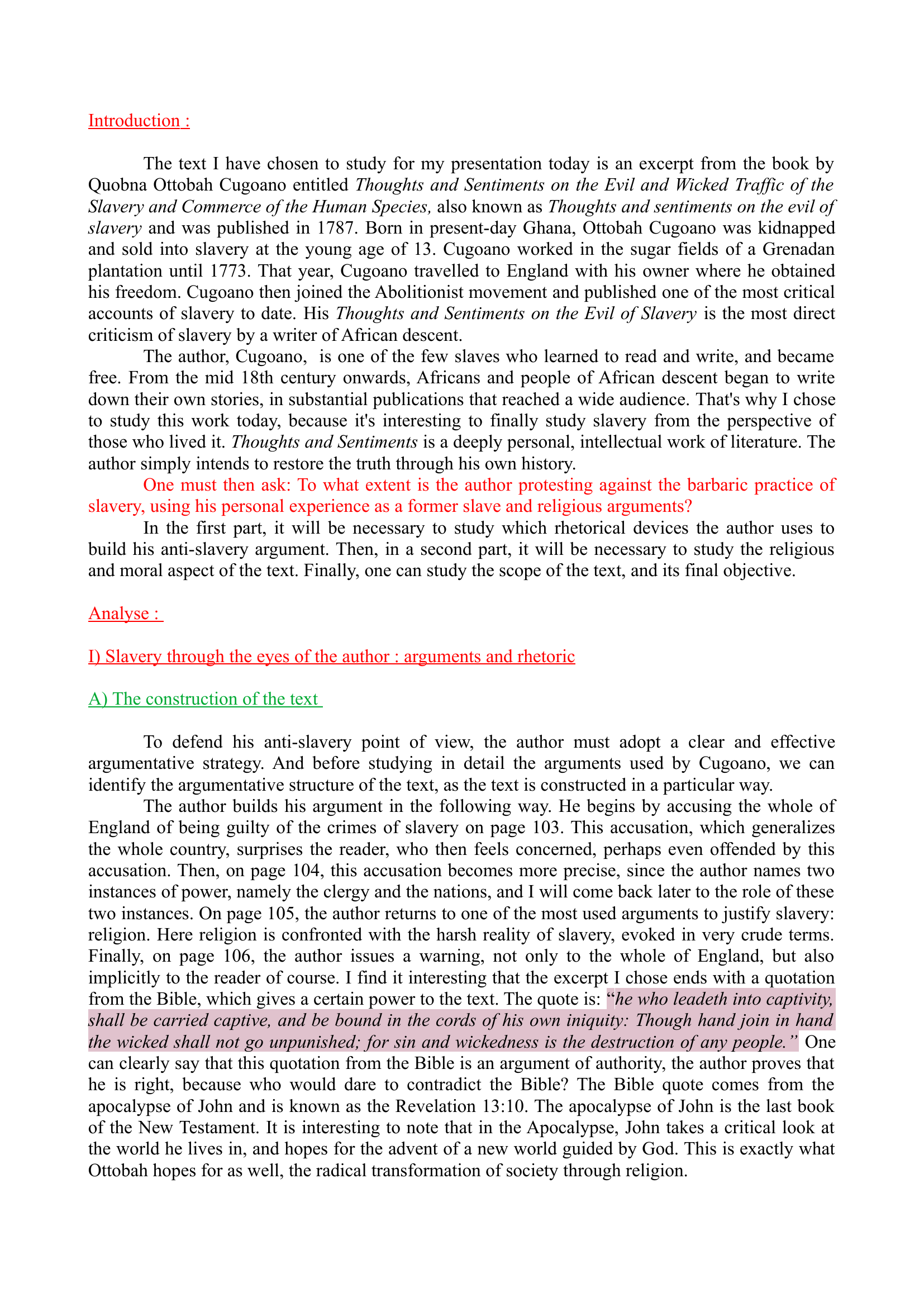Commentaire sur l'ouvrage de Quobna Ottobah Cugoano : Thoughts and Sentiments on the Evil of Slavery
Publié le 20/02/2022

Extrait du document
«
Introduction :
The text I have chosen to study for my presentation today is an excerpt from the book by
Quobna Ottobah Cugoano entitled Thoughts and Sentiments on the Evil and Wicked Traffic of the
Slavery and Commerce of the Human Species, also known as Thoughts and sentiments on the evil of
slavery and was published in 1787.
Born in present-day Ghana, Ottobah Cugoano was kidnapped
and sold into slavery at the young age of 13.
Cugoano worked in the sugar fields of a Grenadan
plantation until 1773.
That year, Cugoano travelled to England with his owner where he obtained
his freedom.
Cugoano then joined the Abolitionist movement and published one of the most critical
accounts of slavery to date.
His Thoughts and Sentiments on the Evil of Slavery is the most direct
criticism of slavery by a writer of African descent.
The author, Cugoano, is one of the few slaves who learned to read and write, and became
free.
From the mid 18th century onwards, Africans and people of African descent began to write
down their own stories, in substantial publications that reached a wide audience.
That's why I chose
to study this work today, because it's interesting to finally study slavery from the perspective of
those who lived it.
Thoughts and Sentiments is a deeply personal, intellectual work of literature.
The
author simply intends to restore the truth through his own history.
One must then ask: To what extent is the author protesting against the barbaric practice of
slavery, using his personal experience as a former slave and religious arguments?
In the first part, it will be necessary to study which rhetorical devices the author uses to
build his anti-slavery argument.
Then, in a second part, it will be necessary to study the religious
and moral aspect of the text.
Finally, one can study the scope of the text, and its final objective.
Analyse :
I) Slavery through the eyes of the author : arguments and rhetoric
A) The construction of the text
To defend his anti-slavery point of view, the author must adopt a clear and effective
argumentative strategy.
And before studying in detail the arguments used by Cugoano, we can
identify the argumentative structure of the text, as the text is constructed in a particular way.
The author builds his argument in the following way.
He begins by accusing the whole of
England of being guilty of the crimes of slavery on page 103.
This accusation, which generalizes
the whole country, surprises the reader, who then feels concerned, perhaps even offended by this
accusation.
Then, on page 104, this accusation becomes more precise, since the author names two
instances of power, namely the clergy and the nations, and I will come back later to the role of these
two instances.
On page 105, the author returns to one of the most used arguments to justify slavery:
religion.
Here religion is confronted with the harsh reality of slavery, evoked in very crude terms.
Finally, on page 106, the author issues a warning, not only to the whole of England, but also
implicitly to the reader of course.
I find it interesting that the excerpt I chose ends with a quotation
from the Bible, which gives a certain power to the text.
The quote is: “he who leadeth into captivity,
shall be carried captive, and be bound in the cords of his own iniquity: Though hand join in hand
the wicked shall not go unpunished; for sin and wickedness is the destruction of any people.” One
can clearly say that this quotation from the Bible is an argument of authority, the author proves that
he is right, because who would dare to contradict the Bible? The Bible quote comes from the
apocalypse of John and is known as the Revelation 13:10.
The apocalypse of John is the last book
of the New Testament.
It is interesting to note that in the Apocalypse, John takes a critical look at
the world he lives in, and hopes for the advent of a new world guided by God.
This is exactly what
Ottobah hopes for as well, the radical transformation of society through religion..
»
↓↓↓ APERÇU DU DOCUMENT ↓↓↓
Liens utiles
- Fiche de lecture sur le chapitre 11: The Greek of the New Testament, par Mark Janse, sur la section IV de l’ouvrage, intitulé: Ancient Greek: structure and change, pages 646-653.
- incubus Roman In folklore and very early religious beliefs, an evil spirit or devil that came out at night and sat on the chests of sleeping people.
- Star Wars Star Wars, science-fiction movie about a young man who joins a rebel group and helps them battle the evil empire.
- Ideology and Rationality in the History of the Life Sciences
- dance and the different types of choreographie process












